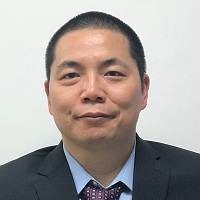- Speaker
- Dr. Qing Peng
- University of Michigan, Ann Arbor, USA
- Abstract
Dislocations are one-dimensional defects and play an essential role in properties of crystalline, including bcc iron. The <100> interstitial-type dislocation loops commonly exist in irradiated ferritic steels as discovered by Transmission Electronic Microscopy studies since early 1960s. The formation mechanism, however, is still a puzzle despite extensive investigations and debates in the past half-century. It is well accepted that the formation energies for <100> interstitial loops are higher than that of <111> interstitial loops. As a consequence, the <100> interstitial loops are unlikely to form since it is energetically unfavorable. The direct observations of the formation of <100> interstitial loops are therefore absent. Part of the reason is that the generation of these loops are too short for experiments, but also thought to be too long for atomistic simulations. Using large scale molecular dynamics simulations with up to 220 million atoms, we directly observed the dynamical process of the generation of the <100> interstitial loops in a single displacement cascade event. The formation mechanism of these loops will be further discussed, as reported in Ref [1].
[1] Q. Peng*, et al., "Shockwave <100> dislocation loops in bcc iron", Nature Communications, (2018), 9, 4880.
- About the Speaker
Dr. Qing Peng is a Research Fellow in the department of Nuclear Engineering and Radiological Sciences, University of Michigan, Ann Arbor. He received his PhD in Physics from University of Connecticut in 2005, MS from Physics department, State University of New York at Binghamton in 2000, and BS in Nuclear Engineering from Peking University in 1998. His research focuses on advanced materials physics using multiscale, first-principles, molecular dynamics, and finite-element modeling and simulations. He is the main developer of the QCDFT (Quasi-Continuum Density Functional Theory), a multiscale method coupling electrons with elements that allows standard density functional theory calculations of materials at micron scales and beyond. The QCDFT method has been used in alloying, plasticity, and fracture mechanics of solids. He have developed “DFT+q” method to accurately model the van der Waals interactions within Kohn-Sham density functional theory frame for defects, interfaces, semihard materials, and soft materials. He also studied the electronic, thermal, thermoelectric, and nonlinear mechanical properties of low-dimensional materials, nanomaterials, electronic materials, and energetic materials. His most recent work includes the radiation damage of materials, high entropy alloys, and oxide dispersion-strengthened (ODS) alloys. Dr. Peng has published over 120 peer-reviewed journal papers with over 2000 citations and an H-index of 25. Dr. Peng serves as an Editorial board member for Scientific Reports since 2015, and Associate Editor of Applied Physics Reviews in 2019.
- Date&Time
- 2019-10-09 10:00 AM
- Location
- Room: A403 Meeting Room




